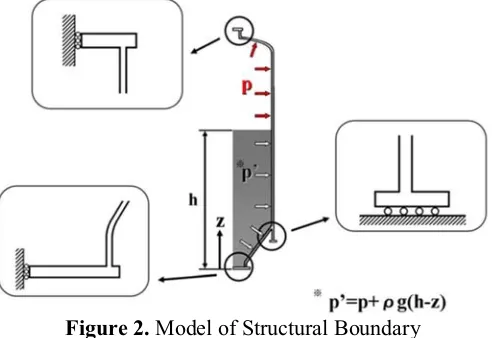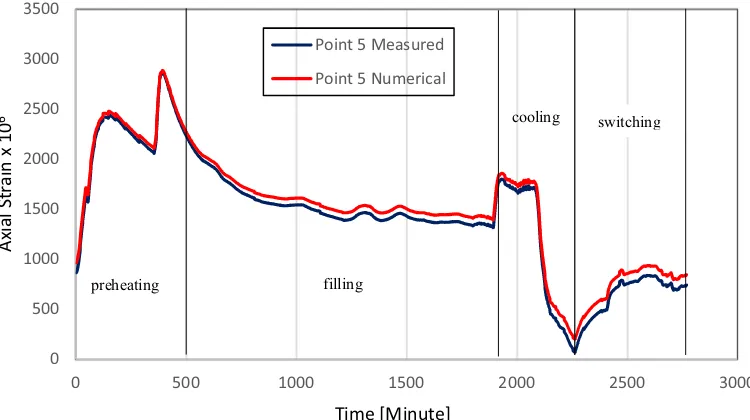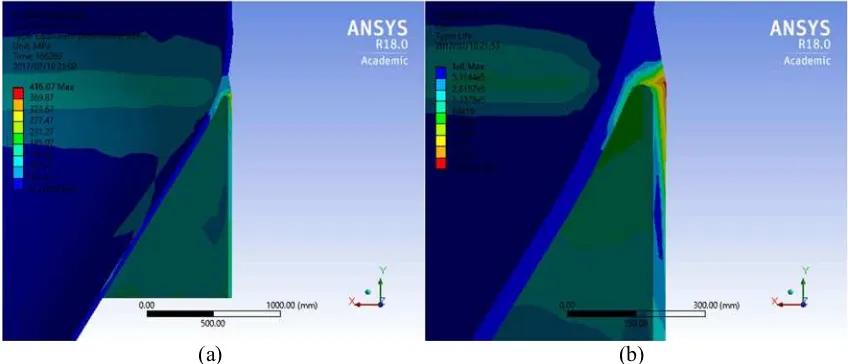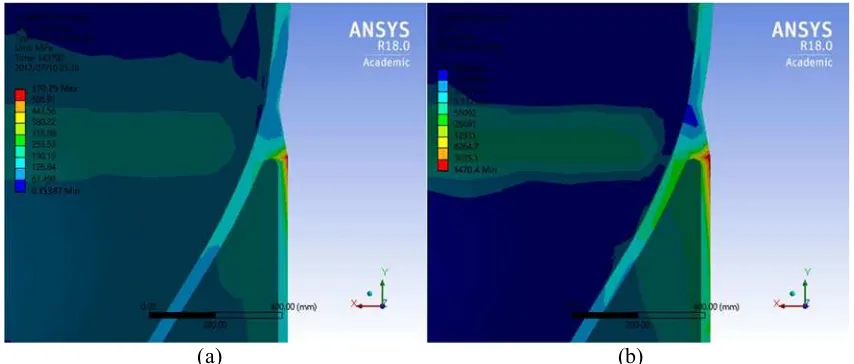IOP Conference Series: Materials Science and Engineering
PAPER • OPEN ACCESS
Transient thermal stresses analysis and thermal
fatigue damage evaluation for skirt attachment of
coke drum
To cite this article: H Ambarita et al 2018 IOP Conf. Ser.: Mater. Sci. Eng.308 012029
View the article online for updates and enhancements.
Related content
Transient natural convection and conduction heat transfers on hot box of a coke drum in Pre-heating stage
A S Siahaan, H Ambarita, H Kawai et al.
-Fatigue Analysis of Proton Exchange Membrane Fuel Cell Stacks Based on Structural Stress Distribution
C.W. Wu, B. Liu, M.Y. Wei et al.
-Fatigue life of metal treated by magnetic field
Liu Zhao-Long, Hu Hai-Yun, Fan Tian-You et al.
Content from this work may be used under the terms of theCreative Commons Attribution 3.0 licence. Any further distribution 1234567890‘’“”
10th International Conference Numerical Analysis in Engineering IOP Publishing
IOP Conf. Series: Materials Science and Engineering 308 (2018) 012029 doi:10.1088/1757-899X/308/1/012029
Transient thermal stresses analysis and thermal fatigue
damage evaluation for skirt attachment of coke drum
H Ambarita*1,2, A S Siahaan1*, H Kawai1, and M Daimaruya1
1Department of Mechanical Systems of Engineering, Muroran Institute of Technology
27-1 Mizumoto-cho, Muroran 050-8585, Japan
2Sustainable Energy Research Centre, Faculty of Engineering, University of Sumatera
Utara, Jl. Almamater Kampus USU Medan 20155, Indonesia
*E-mail: [email protected]
Abstract. In the last decade, the demand for delayed coking capacity has been steadily increasing. The trend in the past 15 to 20 years has been for operators to try to maximize the output of their units by reducing cycle times. This mode of operation can result in very large temperature gradients within the drums during preheating stage and even more so during the quench cycle. This research provide the optimization estimation of fatigue life due to each for the absence of preheating stage and cutting stage. In the absence of preheating stage the decreasing of fatigue life is around 19% and the increasing of maximum stress in point 5 of shell-to-skirt junction is around 97 MPa. However for the absence of cutting stage it was found that is more severe compare to normal cycle. In this adjustment fatigue life reduce around 39% and maximum stress is increased around 154 MPa. It can concluded that for cycle optimization, eliminating preheating stage possibly can become an option due to the increasing demand of delayed coking process.
1. Introduction
Coke drum are categorized into pressure vessel used in oil refinery to convert the heavy residual into lighter product by using thermal cracking due to delayed cooking process. In delayed cooking process, the heavy residual feed oil is heated into thermal cracking temperature in order to separate petroleum coke from the lighter. The remains coke then quenched to make possible to safely take out from the drum. Nowadays, because of the increasing demand of lighter oil is increasing affecting the increasing of coke drum instillation in whole world.
Coke drum undergoes cyclic high temperature and suddenly cooling. Thus its operational life is much shorter in comparison to other equipment in oil refinery. In fact, coke drum is designed based on ASME Boiler and Pressure Vessel Codes Section VIII Division I [1]. Concisely, most of coke drum is not designed for cyclic load. It is convinced that, the fracture mechanism in a coke drum is dominated by thermal fatigue.
2
1234567890‘’“”
10th International Conference Numerical Analysis in Engineering IOP Publishing
IOP Conf. Series: Materials Science and Engineering 308 (2018) 012029 doi:10.1088/1757-899X/308/1/012029
Figure 1. Coke Drum and Typical Coke Drum Cycle
In the present because the high demand of lighter oil, high rate production in oil refinery is extremely needed [3]. Nowadays, petroleum companies tends to cut the cycle time of delayed cooking process due to enhance the production rate, thus coke drum cycle will be as short as 2000 to 2400 minutes, which means more severe cycle and shorter fatigue life of the drum.
The main objective of this research is to observe the effect of shortening cycle time of coke drum, with consideration to mutual benefit of shorter fatigue life due to higher stress intensity compare to enhance production process of coke. Further analyses will conducted to compare fatigue life of coke drum on full cycle, preheating excluded, and cutting stage excluded. The result can be used to estimate fatigue life of coke drum with consideration of two stages exclusion.
2. Method
Thermocouples and strain gauge were inserted in to coke drum, located around shell-to skirt junction area. Operational strain and temperature history of coke drum were collected which in minute interval. Coke drums made by low alloy steel SA-387 Gr.11 CL.2. The cladding inside the coke drum is made of 3 mm thick SA 240TP. 410S material. Thickness of shells vary within the range 28.5 mm – 34 mm and the skirt thickness are 24 mm. Ratio between diameter and wall thickness of the coke drum varied from 125 to 150 mm/mm. The coke drum material density is 7850 kg/m3 and 40.6 W/mK for thermal conductivity. For the insulator we used ambient temperature model outside of the skirt and shell of the coke drum. In this analyses the wind, piping, and seismic overturning moments are excluded.
Figure 2. Model of Structural Boundary
1234567890‘’“”
10th International Conference Numerical Analysis in Engineering IOP Publishing
IOP Conf. Series: Materials Science and Engineering 308 (2018) 012029 doi:10.1088/1757-899X/308/1/012029
and Pressure Vessel Code section II part D), shown in table 1. The model for numerical analyses is half segment of the coke drum.There are two mesh model were tested in this simulation which is 25675 and 41351 nodes. The strain result is almost the same but for the better result the model with 41351 nodes was selected for analyses.
Table 1. Temperature dependent material properties
Analyses on estimation coke drum fatigue life were performed, which is treated as follows: strain comparison from selected cycle which gathered from strain gauge is compared to the numerical result. Selected cycle have total time of 2771 minutes. Similar with the temperature plot history, we can divided the strain result to preheating, filling, cooling and cutting stage.
Figure 3. Comparison of Numerical and Measured axial strains
The comparison result show for full cycle were performed and show a good agreement between numerical and measured data shown in figure 3 above. After validating result between numerical and
0
0 500 1000 1500 2000 2500 3000
4
1234567890‘’“”
10th International Conference Numerical Analysis in Engineering IOP Publishing
IOP Conf. Series: Materials Science and Engineering 308 (2018) 012029 doi:10.1088/1757-899X/308/1/012029
measured data, some adjustments for next simulation were implemented. For the first adjustment the cutting stage is excluded which total time of 2398 minutes. The second is when the preheating stage is excluded that cut total time cycle to 2416 minutes. Further analyses will performed to compare the result of the exclusion of these two stages.
3. Result and Discussion
The main objective of this research is to observe the effect of shortening the cycle time of coke drum. The thermal fatigue life of coke drum carried out in the most severe part of the coke drum at the shell-to-skirt junction area. Good agreement between numerical and measured strain result, allowed us to perform further analyses of fatigue life estimation of coke drum using numerical code. Because the data which we gather were strain data, fatigue life estimation which will we performed is strain life fatigue analyses.
The elastic modulus using for this equation is based on temperature was iterated from the input data from ASME Boiler and Pressure Vessel Code section II part D. From numerical analyses for full cycle which is shown in contour of stress intensity in fig. 4(a) we found that the shell-to-skirt junction is the most severe area especially in area around point 5. This result have the same result compare to previous research of the same coke drum by Oka et.al [2]. The result shows the highest axial strain distribution in junction area. For full cycle it was found that maximum stress intensity is 416 MPa.
(a) (b)
Figure 4. (a) Contour of stress intensity and (b) contour of fatigue life of full cycle
From the contour of fatigue life in figure 4(b) above we found the estimation for fatigue life of full cycle is around 2394 cycles, for this particularly selected cycle. From contour of fatigue life in figure 4(b) it also shown shell-to-skirt junction is the area with the shortest fatigue life, comparing to another part in coke drum. Therefore for future research some focuses due to stress development and maintenance in this area need to be implemented.
As the aforementioned before, some adjustment was conducted. Using numerical analyses the estimation of coke drum’s fatigue life with elimination for each preheating and cutting stages were performed. The first adjustment is full cycle without preheating stage. Contour of stress intensity in fig. 5(a) shows the same point of most severe part of coke drum also occurred in point 5. Although the stress intensity shows the same area of occurrence, but there are increasing of maximum stress around 97 MPa.
1234567890‘’“”
10th International Conference Numerical Analysis in Engineering IOP Publishing
IOP Conf. Series: Materials Science and Engineering 308 (2018) 012029 doi:10.1088/1757-899X/308/1/012029
(a) (b)
Figure 5. (a) Contour of stress intensity and (b) contour of fatigue life of cycle without preheating stage
For the second adjustment is coke drum cycle without cutting stage. In this type of cycle, it found the increasing of maximum stress intensity of 154 MPa compared to normal cycle. From contour of fatigue life in figure 6(b), it was found that the estimation life of coke drum decreasing drastically to 1430 cycles. Around 39% compare to the normal cycle. This phenomena was not expected before, because in cutting stage there are no sudden change in stress and temperature. Therefore, further understanding on cutting stage’s characteristics is necessary.
(a) (b)
Figure 6. (a) Contour of stress intensity and (b) contour of fatigue life of cycle without preheating stage
The main objective of cutting stage is to cut the coke bed, causing the coke bed to collapse in on itself and for the coke water slurry to drain through the pilot hole and out of the bottom the drum through the raised chute and into the coke pit or pad below the coke drum structure. When the coke have been cut from the drum, the chute is lowered, the bottom cover is re-attached and bolted to the coke drum and the feed line connected to its mating section on the bottom cover. At this time the drum is steam tested for tightness and then is heated by introducing steam into the feed line, which shown by the increasing temperature for some amount of time in cutting stage.
6
1234567890‘’“”
10th International Conference Numerical Analysis in Engineering IOP Publishing
IOP Conf. Series: Materials Science and Engineering 308 (2018) 012029 doi:10.1088/1757-899X/308/1/012029
of cutting stage. In preheating stage, after rapid heating, filling stage might acted as heat treatment. As we can see in the in figure 3, strain rate in this filling stage is showing no significant fluctuation, which we can that this stage turn into steady state. It also shown in figure 1 for temperature plot, after preheating stage temperature is almost steady and it turn to steady heat transfer. Thus, even with the absence of preheating it turn to less damage compare to the absence of cutting stage.
Other things is, when some part of the plat is cooled, contraction of the outer layer causes tension. Failure when it occurs, is initiated somewhere at the surface or its near vicinity. When the parts is heated, however, expansion of the surface layers causes compression which is balanced by tensile stresses in the central region [4]. Although shear induced by the compression may cause surface spalling, the more critical type of failure occurs when a tensile crack develops in the inner region. Some research was conducted this phenomena [5, 6, 7, 8, 9], in which some uncertainties existed regarding the validity of the calculations of the stresses and in which the rate of the loading was much higher for cooled specimen. These data showed that alumina had much higher strength in the case of heating than in the case of cooling. Depending on specimen size, the strength in heating can be as great as two times the strength in cooling.
With the absence of cutting stage, the cycle will undergoes simultaneous rapid cooling and sudden rapid heating. Thus, fatigue life of material in case of the absence of cutting stage is more severe compare to the absence of preheating stage, not to mention cutting stage is the stage where water jets cut into the coke bed, cleaning the remaining coke bed which still adhere in inner wall of coke drum. Without cutting stage, the remaining coke bed in inner shell will aggravate to the next cycle, such as the disruption heat distribution from inside wall to outside part coke drum and the occurrence of hot spot and cold spot due to remaining coke' which is not taken into consideration in simulation. Thus fatigue life estimation without cutting stage in this simulation most likely was predicted to high compare to the real situation if cutting stage indeed will eliminated [10].
The option to shorten delayed cooking process will eventually lead to more severe stress and shorter fatigue life. Analyses optimization shows that comparing between the absence of preheating stage and cutting stage for enhance production, indicate that the cycle without preheating stage can become an alternative. With moderate rise in stress intensity and fatigue life reduction.
4. Conclusion
In this research, numerical analyses to estimate fatigue life of coke drum were performed. From the numerical analyses it was found that the most severe area is in shell-to-skirt junction, for every kind of adjustment, either it was full cycle, without preheating and without switching stage.
In the absence of preheating stage it turn that maximum stress intensity increase of 97 MPa compare to normal cycle as well as the decreasing of fatigue life around 19% from normal cycle. In the absence of switching stage it turn that maximum stress intensity increase of 154 MPa compare to normal cycle and the decreasing of fatigue life around 39%.
The main conclusion is the absence of cutting stage is more severe compare to the absence of preheating stage. As the aforementioned before, cutting stage acted like a heat treatment, and the absence of cutting stage resulting in unavailability of intermediate stage between cooling and preheating stage which means rapid cooling and rapid heating repeatedly. Thus for cycle optimization, eliminating preheating stage can be an option, due to the increasing demand of petroleum product.
References
[1] ASME 2007 ASME Boiler & Pressure Vessel Code, Section II, Part D, Properties-Material (ASME)
[2] Oka A, Ambarita H, Daimaruya M, Fujiki H 2011 ASME Pressure Vessel Technology133 (6)
061210
[3] Ramos A, Rios C, C Vargas, J Tahara, and T Hasagewa 1997 ASME PVP359 pp 291-298
[4] S. S Manson 1966 Thermal Stress and Low-Cycle Fatigue (McGraw-Hill) p 303 [5] W B Crandall et.al 1955 J Am Ceram Soc38 p 44
1234567890‘’“”
10th International Conference Numerical Analysis in Engineering IOP Publishing
IOP Conf. Series: Materials Science and Engineering 308 (2018) 012029 doi:10.1088/1757-899X/308/1/012029
[7] Oka M, Ambarita H, Kawashima K, Daimaruya M 2010 ASME Pressure Vessels and Piping7 pp 37-43
[8] Ambarita H, Daimaruya M, Fujiki H, Kawai H, Kobayashi H and Oka M 2012 Journal of Thermal
Stresses35(12) pp 1095-1107
[9] Oka M, Ambarita H, Daimaruya M, Fujiki H 2010 Journal of Thermal Stresses33(10) pp 964-976
[10] Daimaruya M, Oka M, Fujiki H, Ambarita H, Yamada T and Tomizawa K 2009 The 12th



